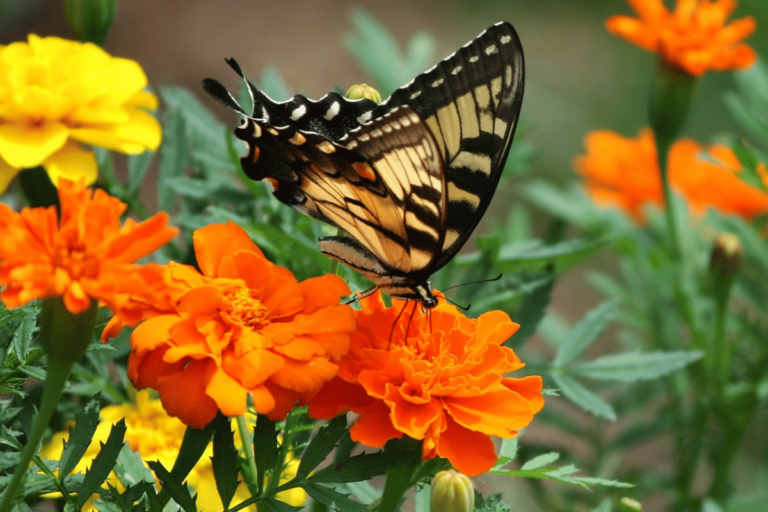Butterflies’ Preferred Plants
When creating a butterfly garden, you have to choose your plants wisely so that they provide nectar and host sites for butterflies. Brightly coloured flowers with plentiful nectar attract butterflies like plants that their larvae can use for food. The following are some nectar plants commonly known as “butterfly bushes”:
Butterfly Bush (Buddleja): It has a sizeable fibrous inflorescence that exudes an aroma that entices many butterfly species. All through the summer period, nectar is always produced.
Example: ‘Black Knight’ is one of the most common types having dark purple blossoms.
Coneflower (Echinacea): Coneflowers produce vibrant blooms filled with sweet nectar throughout summer. They are hardy and grow well, making them ideal for any butterfly garden.
Example: Magnus is an extensively grown variety with big purplish pink flowers.
Lantana: With its flowers of various colours, lantana attracts both butterflies and other pollinators. This plant thrives in sunny positions as it has high heat tolerance.
Example: ‘Miss Huff’ is a robust variant due to its multi-coloured blooms.
Milkweed (Asclepias): Milkweed is a source of nectar and a host plant for monarchs during their larval stages. Monarchs require milkweed to complete their life cycle.
Example: The “Common Milkweed” or Asclepias syriaca is a native species supporting monarch caterpillars.
Aside from having nectar plants, include host plants specific to certain butterfly species. For example, parsley, dill and fennel are hosts for swallowtail, while passion flower is a host plant for gulf fritillary. Providing a mixture of nectar and host plants will result in diverse and supportive environments for the butterflies.
Successful Butterfly Habitat Tips
The following tips and strategies will help you create a thriving butterfly habitat:
Sunny Location: Because they are cold-blooded and regulate their body temperature by sunning themselves, butterflies must inhabit places that receive sunlight. The garden should be exposed to direct sun light at least six out of twenty-four hours.
Example: Put your garden where it catches the morning sun so butterflies can warm up early in the day.
Plant in Clusters: Help butterflies locate and reach flowers easily by planting them in groups. A more attractive visual appears when similar plants are bunched together, and a better garden design is used.
Example: Group three or more specimens of any given species together to make a bold statement with colour and bring more butterflies.
Seasonal Blooming: Different flowering plants blooming at different periods can give the required nectar throughout the year.
Example: To include violets that bloom early, coneflowers which bloom during mid-season, and asters which flower late on can provide a continuous supply of nectar throughout the year in your garden.
Water Sources: Water sources like shallow dishes filled with water and stones for resting on top are meant to ensure hydration among butterflies.
Example: Fill a shallow dish with sand and water for a butterfly puddling station.
Basking Spots: Butterflies need flat rocks or other surfaces they can rest on to get warmed up under sunlight, creating such spots for them.
Example: Position flat stones in sunny spots throughout the garden for butterflies to use as warming platforms.
Shelter: Windbreakers should be there while predators must also be kept away by incorporating shrubs, tall grasses, and others into the habitat.
Example: Native shrubs like spicebush or tall grasses like switchgrass will create hideaways and cover.
Avoid Pesticides: When it comes to pesticides, you must evade them because they can also destroy butterflies and other beneficial insects. To maintain a healthy and balanced ecosystem, use organic gardening and natural pest control methods.
Example: Enhance this by introducing ladybugs and lacewings for pest control.
By creating a butterfly-friendly garden, you will be able to appreciate the aesthetic appeal that nature offers while still supporting its conservation efforts. Your backyard will become a sanctuary for butterflies, where they will get all the materials necessary for proper development.
Explore More Gardening Tips and Ideas
- Growing Bonsai: Tips for Miniature Tree Enthusiasts
- Buying Bonsai: Tips for Selecting Your Perfect Tree
- Bonsai Potting: Essential Tips for Tree Care Success
- Bonsai Maintenance: Essential Care for Tiny Trees
- Mastering the Art of Shaping Bonsai: A Beginner’s Guide
Source: Home Butterflies Garden


